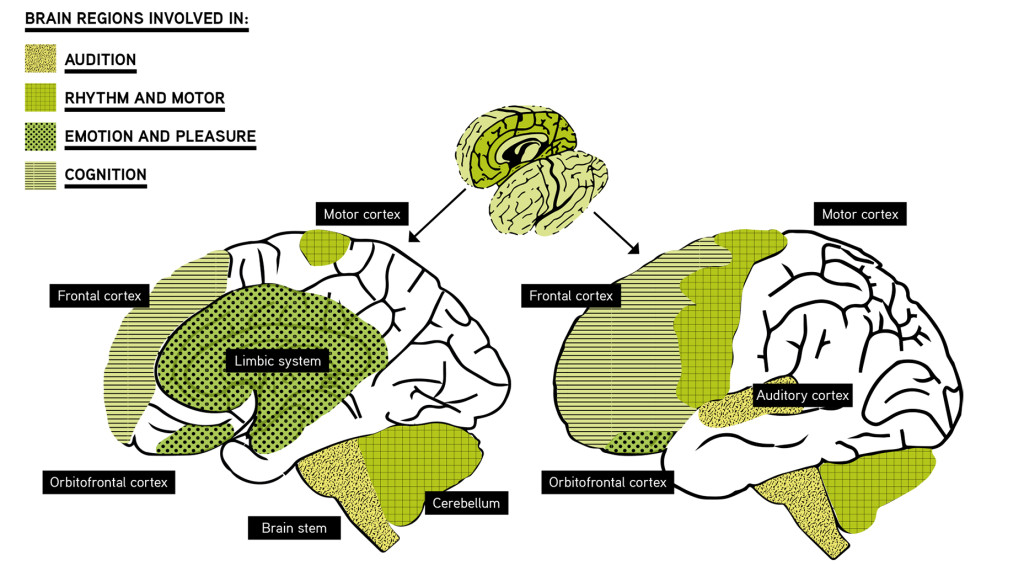
The widespread brain processing involved in musical activities is coupled with release of a range of neurochemicals, which are of large importance to the health benefits of listening to music. One of the neurotransmitters that has received most research interest in music studies is dopamine. Dopamine is involved in two central functions: rhythm and anticipation/pleasure.
Musical pleasure involves the brain’s reward system, and dopamine is a key neurotransmitter within these structures. The dopaminergic reward system has consistently been associated with the pleasure experienced from a range of physiological and psychological rewards, from the pleasure of sex and gambling, to the taste of chocolate or the pleasure of a good laugh (Berridge and Robinson, 1998; Frijda, 2010; Georgiadis and Kringelbach, 2012; Kalivas and Volkow, 2005; Knutson and Cooper, 2005; Kringelbach et al., 2012; Mobbs et al., 2003; Morgan et al., 2002; Pfaus, 2009; Robbins and Everitt, 1996). In a brain-imaging study in healthy participants, it was found that the intensity of pleasurable music induced chills correlated with activity in the brain’s reward circuitry, including the areas high in dopamine receptors (Blood and Zatorre, 2001; Salimpoor et al., 2013).
Dopamine interacts with other neurotransmitters in the brain – of special interest here is oxytocin and the opioid system. In particular, oxytocin-projections from the amygdala and nucleus accumbens display strong interactions with the dopamine system. Oxytocin is a neurohormone, and has colloquially been dubbed the ‘cuddle hormone’ or ‘love drug’, because of its role in reproduction and social bonding. It has been suggested that the capacity to engage in temporally matched interactions, such as music, is associated with the release of oxytocin (Feldman, 2007). Correspondingly, music is highly efficient in synchronizing movements (Repp, 2005), emotions (Huron, 2006; Juslin and Vastfjall, 2008) and even physiological responses, such as heart rate and blood pressure between people (Olsson et al., 2013). Temporally matched interactions are central for music-making, which is pleasurable, motivating and creates social bonds between people who play or listen to music together. Indeed, singing in groups (Grape et al., 2002) and passive music listening (Nilsson, 2009b) leads to an increase in peripheral oxytocin. This might explain why music is so commonly used in social situations and why we experience a strong sense of community when singing together or being at a large concert; hinting at a possible survival value of musical activities.
Opioids are the body’s natural painkillers and are released during music listening (Chanda and Levitin, 2013; Stefano et al., 2004). On the one hand, opioids might be central for the peace and relaxation we can experience from certain music, but on the other hand, opioids also seem to be responsible for the strong emotions or pleasure we experience from listening to music. One study found that when the effect of opiates was blocked, people did not experience chills when listening to music (Goldstein, 1980). Thus, opioid activity might be central for the pleasurable responses/experience of music, as well as the analgetic effect of music.
Finally, music affects the HPA axis (hypothalamic-pituitary-adrenal). The HPA axis is a major part of the neurochemical system that regulates a number of body functions, such as the immune system, arousal and stress, attention, mood and emotion. It is a sensitive system, controlling the release of several hormones, and affecting both the central and peripheral nervous system. The HPA axis also controls the hormone cortisol, which is crucial for sleep/wakening cycles, arousal and stress reactions. The effect of music on the HPA axis is closely linked to the general effect on arousal, and contributes to both the relaxing and energizing properties of music. Music has also been shown to modify heart rate, respiration rate, perspiration, and other autonomic systems (Loomba et al., 2012), which has importance for the potential use of music in the healthcare system.
